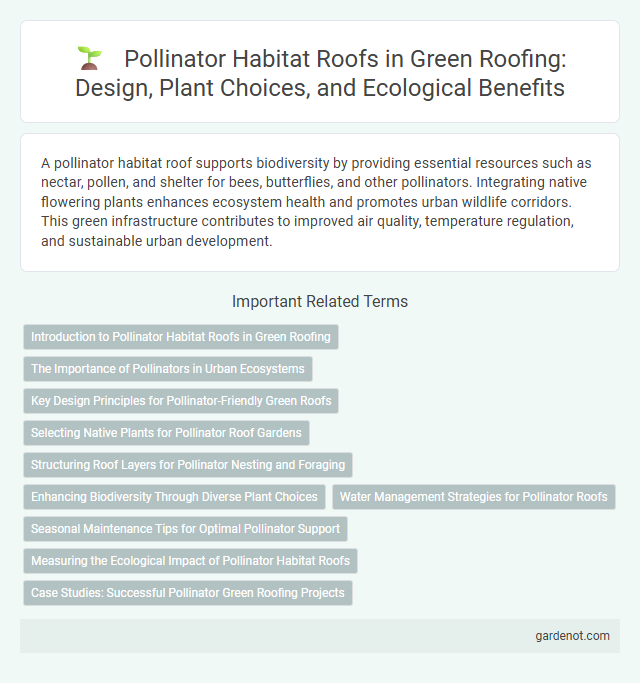A pollinator habitat roof supports biodiversity by providing essential resources such as nectar, pollen, and shelter for bees, butterflies, and other pollinators. Integrating native flowering plants enhances ecosystem health and promotes urban wildlife corridors. This green infrastructure contributes to improved air quality, temperature regulation, and sustainable urban development.
Introduction to Pollinator Habitat Roofs in Green Roofing
Pollinator habitat roofs are specialized green roofs designed to support and attract essential pollinators such as bees, butterflies, and hummingbirds by incorporating native flowering plants and diverse vegetation. These roofs enhance urban biodiversity, improve air quality, and contribute to the pollination of surrounding flora, creating ecological benefits in densely built environments. Integrating pollinator habitats into green roofing systems promotes sustainable urban development while addressing the global decline of pollinator populations.
The Importance of Pollinators in Urban Ecosystems
Pollinator habitat roofs provide critical urban refuges for bees, butterflies, and other pollinators essential for biodiversity and food production. These green roofs enhance ecosystem services by supporting native plant species that rely on pollination, thereby strengthening urban flora resilience. Integrating pollinator-friendly vegetation into rooftop landscapes helps mitigate habitat loss and promotes ecological balance within densely populated cities.
Key Design Principles for Pollinator-Friendly Green Roofs
Key design principles for pollinator-friendly green roofs emphasize diverse native plant selections adapted to local pollinators, ensuring continuous bloom cycles for sustained nectar and pollen availability. Soil depth and substrate composition must support root development and moisture retention to create a resilient habitat. Incorporating structural diversity with varied plant heights and nesting materials fosters shelter and breeding opportunities for diverse pollinator species.
Selecting Native Plants for Pollinator Roof Gardens
Selecting native plants for pollinator habitat roofs enhances local biodiversity by providing essential nectar and pollen sources tailored to native bees, butterflies, and other pollinators. Native species like purple coneflower (Echinacea purpurea), milkweed (Asclepias spp.), and black-eyed Susan (Rudbeckia hirta) thrive in rooftop conditions, requiring less maintenance and offering greater resilience to pests and climate variations. Incorporating a diverse mix of flowering plants with staggered bloom periods ensures continuous food availability, supporting pollinator health and promoting sustainable urban ecosystems.
Structuring Roof Layers for Pollinator Nesting and Foraging
Structuring roof layers for pollinator nesting and foraging involves incorporating diverse vegetation including native wildflowers, grasses, and shrubs to provide ample nectar and pollen sources. Substrate layers must include varying soil depths and textures that create suitable microhabitats for ground-nesting bees and other pollinators. Integrating water retention materials and nesting cavities enhances habitat quality, supporting pollinator biodiversity and ecosystem health in urban environments.
Enhancing Biodiversity Through Diverse Plant Choices
Pollinator habitat roofs significantly enhance urban biodiversity by incorporating a wide variety of native flowering plants that provide essential nectar and pollen sources. Selecting plant species with staggered bloom periods ensures continuous food availability for bees, butterflies, and other pollinators throughout the growing season. These diverse plant choices create resilient ecosystems that support pollinator health, improve urban air quality, and contribute to local ecological balance.
Water Management Strategies for Pollinator Roofs
Pollinator habitat roofs integrate specialized water management strategies to optimize hydration while preventing runoff. These green roofs utilize drought-tolerant native plants and engineered soil media to retain moisture, promoting sustained nectar and pollen production for pollinators. Incorporating rainwater harvesting systems and permeable layers enhances water infiltration, reducing urban stormwater impact and supporting a resilient pollinator ecosystem.
Seasonal Maintenance Tips for Optimal Pollinator Support
Seasonal maintenance for pollinator habitat roofs includes regular inspection and removal of invasive species to preserve native plant diversity essential for pollinators. Timely pruning and deadheading promote continuous flowering cycles, ensuring a steady nectar and pollen supply throughout spring to fall. Irrigation adjustments during dry summer months prevent plant stress, supporting robust pollinator activity and habitat sustainability.
Measuring the Ecological Impact of Pollinator Habitat Roofs
Pollinator habitat roofs significantly enhance urban biodiversity by providing essential resources for bees, butterflies, and other pollinators, directly contributing to ecosystem health. Measuring the ecological impact involves assessing pollinator visitation rates, species diversity, and reproductive success on these green roofs compared to conventional rooftops. Data gathered through systematic monitoring informs urban planning strategies aimed at restoring pollinator populations and improving ecosystem services in densely populated areas.
Case Studies: Successful Pollinator Green Roofing Projects
Case studies of pollinator habitat roofs demonstrate significant increases in local bee and butterfly populations, supporting biodiversity in urban environments. Projects such as the Chicago City Hall Green Roof and the Vancouver Convention Centre Green Roof have shown that integrating native flowering plants creates thriving ecosystems while improving air quality and reducing urban heat. These successful installations provide scalable models for cities aiming to enhance pollinator habitat through green roofing initiatives.
Pollinator habitat roof Infographic

 gardenot.com
gardenot.com